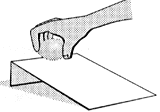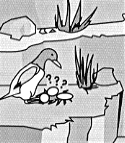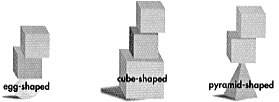 |
 |
|
|
|
|
Student Work is presented as discrete examples from various
students according to point level rather than as an individual student's
complete work. 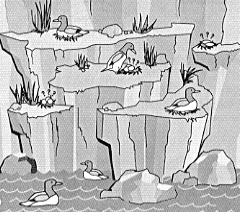
[This is an example of "Context" as used in 4th grade performance tasks. The student reads about the task and the background relating to the problem they are to solve.] 
When Maria was looking through books about birds, she noticed pictures of the Common Murre nesting on cliffs above the sea. Maria wondered why the birds' eggs didn't roll off the cliffs. She also wondered what the eggs were made of since they did not seem to break while resting on the hard rocky ledges. Maria knew that egg shape and egg materials are like bird beaks
- each special structure has a special job. In the activities of
this experiment, you will study about bird eggs. At the end of your
experiments, you will decide the best shape for eggs that rest on
cliffs. [There are no examples of student work available for Questions
A and B.] Bird eggs are not all the same.A. The strength of a bird's egg depends on many things. Use an "X" to mark things that can make a bird's egg strong. You may mark more than one answer. _______ The shape of the egg. _______ The color of the egg. _______ The material the shell is made of. _______ The size of the egg. _______ The thickness of the shell. _______ The size of the yolk. B. Choose ONE of the things you marked in question B and
tell how you know it makes an egg strong. [Here, students begin the "hands on" portion of the performance
task.] Part A: How does the shape of an egg make a difference? You will now experiment with model eggs to see which shape is best for rocky ledges. Take the cardboard ramp and three wooden eggs out of the bag.
STEP 1 STEP 2 Place the ramp so it faces away from you. Clear your desk so there are no papers or materials near the ramp.
STEP 3 Set the egg on its side and roll it from the top of the ramp away from you onto the table.
STEP 4 Carefully watch how it rolls ON THE TABLE.
[Bird Eggs: Question 1 measures design and aquisition - collect
and represent data.] 1. In the table below, draw a line that shows a path that each egg takes as it rolls on the table. For example, if the egg rolls straight after it leaves the cardboard ramp, you would draw a line like the sample below. Be sure to roll ALL THREE eggs. Draw the paths below. Score = 4 Students were quite successful in the initial task of collecting
and recording data. 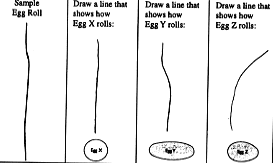
Egg Shape Observation[Bird Eggs: Question 2 measures the students ability to collect and represent data. This falls into the cluster of Design and aquisition. Bird Eggs: Questions 1 and 2 are also designed to measure
physical science concept- Position and motion of objects, such as
how the motion of an object can be described.] 2. Complete the following table. Score = 4 Note that the words tell that one egg rolled left and one rolled
right AND that the drawing show that the eggs rolled in opposite
directions. This is an example of internal consistency between the
graphical representation and the written description of motion.
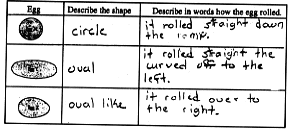
[Bird Eggs: Question 3 measures life science concept- Characteristics
of organisms- relationship of structure and function. In addition
it measures evidence and analysis- argue from evidence.]
3. Does the shape of each egg make a difference in the way it rolls?
Explain your answer.
Score = 2 The student uses evidence from the previous task to clearly
describe why the shape of each egg makes a difference in the way
the egg rolls. 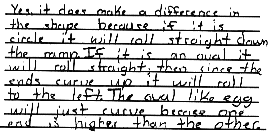
Score = 1 The student response "all... are going to go a different way"
is an incomplete use of evidence from the previous task. 
 Sometimes it helps to look at the results of other people's
experiments. Here are some drawings other students made of how each
of the eggs rolled when released from the ramp. 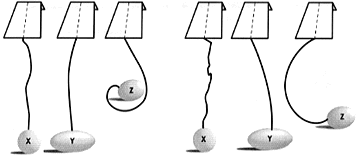
[Bird Eggs: Question 4 is designed to measure a student's
understanding of life science concept- how environment determines
the characteristics of an organism. It also measures evidence and
analysis- synthesize multiple pieces of information or data to evaluate
an issue or solve a problem.] 4. After rolling the eggs and looking at the drawings of the other
students above, which of the eggs do you think would be best for
a bird that lays its eggs on a bare, rocky ledge? Why? Score = 3 The student response is detailed and complete. The student's
reasoning is clearly explained with multiple reasons to support
choice of egg shape that is best suited to the environment. 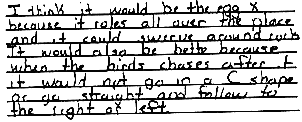
Score = 2 A recommendation about the egg shape best suited for the environment
is given. However, the errors in reasoning provide only partial
evidence that the student is able to use information to construct
ideas. The student does attempt an explanation, however, and that
is what earns this response a score of 2 rather than 1. 
Score = 1 Although the student makes a choice of egg shape best suited
for the environment, no explanation is given. A choice was made,
which is what gives this student's paper a 1 rather than a 0. 
Part B: Are some shapes stronger than others? 
Which shape would be the strongest? To test this, Maria put blocks on top of 3 shapes until the weight made them break.
[Bird Eggs: Question 5 measures physical science concept- properties of objects and materials. It also measures evidence and analysis- argue from evidence. In the 4th grade Spring Pilot, students were not able to
give answers to question 5 that fit level 2 of the scoring guide.
The phrase in level 2 that was difficult for students to achieve
was "uses evidence... to support their conclusions.] 5. Does shape affect strength? Use the results of the strength tests shown above to explain which shape is strongest.
Score = 1 The student response does not include evidence from the strength
test to support the given conclusion. 
Score = 1 The student gives conflicting information in the response. 
Score = 0 No evidence supporting the choice given. 
[Students are now asked to explore other variables that might
affect what types of eggs would be best suited for survival on a
rocky ledge.] Part C: Does the material of an egg shell affect its strength? You will now do a test on the crushed pieces of egg shells to determine if what a shell is made of affects how stiff or breakable it is.
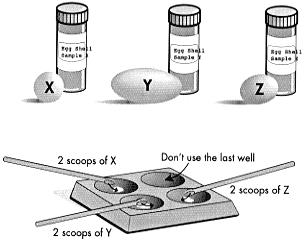
STEP 1 Place 2 scoops of each powdered egg shell into different wells
in the tray.
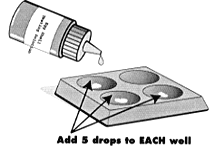
STEP 2 Add 5 drops of the Egg Shell Testing Solution.
[Bird Eggs: Questions 6 and 7 measure physical science concept- properties of objects and materials... the ability of materials to react with other substances. Bird Eggs: Question 6 measures design and acquisition- collect and represent data.]  6. Write down what you see happening in each well in the table below.
Score = 2 Students proved themselves to be quite proficient at the task
of collecting and recording data. The data table is complete and
gives a detailed description of student observations of the egg
shell test. 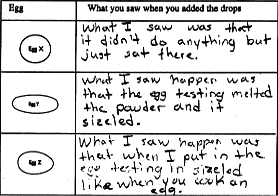
[Bird Eggs: Question 7 measures the ability of students to
synthesize multiple pieces of information and data to evaluate an
issue or solve a problem. This falls into the evidence and analysis
cluster. Question 7 also measures life science concept characteristics
of organisms- survival and environmental support and relationship
between structure and function.] 7. The material in the egg shell that makes it bubble is the material that makes the egg shell stiff and strong. Which of the sample egg shell materials would be best for a bird that nests on a rocky ledge?
Score = 2 The student's reasoning is explained and the choice of egg shape
best suited to the environment is supported with data and observations
from the previous question. 
Score = 1 Although the student makes a choice of egg shape best suited
for the environment, no explanation is given in either case. A choice
was made, which is what gives this student response a 1 rather than
a 0. 
Part D: What can we conclude about the eggs?[Bird Eggs: Question 8 measures scientific thinking; evidence
and analysis cluster, which requires students to synthesize multiple
pieces of data to evaluate an issue or solve a problem.] 8. Now you will compare the eggs to determine which one would be best for a bird that nests on a rocky cliff. For each of the rows or "tests" in the table below, give each egg a score for how good it would be on a rocky ledge.
Score = 2 The question 8 table is complete. Each test includes a comparative
rating for each egg. 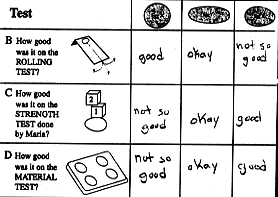
Score = 1 Although the student response is complete, the information recorded
for Test B and Test D shows no differentiation between the three
egg samples. This does not match information previously recorded. 
Score = 0 An incomplete response is given. 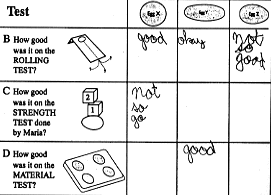
[Bird Eggs: Question 9 measures life science concept- life
cycles of organisms... how environment determines characteristics
of an organism. It also measures the student's ability to synthesize
multiple pieces of information and data to evaluate an issue or
solve a problem. These are characteristics of the evidence and analysis
cluster.] 9. Which one of the three tests (A, B, or C) tells you the most important information about eggs that might be found on rocky cliffs? Why?
Score = 2 The student has made a decision about the effectiveness of the
tests used in this task. In addition, the response indicates a reason
why this test provides useful information in choosing which egg
is best suited to the environment. 
Score = 1 This student response contains errors in reasoning and only
vaguely communicates the student's ability to evaluate and use the
scientific method. 
Score = 0 Although a response is given, this student response was scored
a 0 rather than a 1 because it provides no evidence that the student
is able to use tools or methods of scientific study. 
[Bird Eggs: Question 10 measures life science concept- characteristics
of organisms- survival and environmental support. It also measures
the student's ability to synthesize multiple pieces of information
and data to evaluate an issue or solve a problem. These are characteristics
of the evidence and analysis cluster.] 10. Based on the tests you did on the three eggs (X, Y, and Z), which egg would be the best for a bird that lives on a rocky ledge? Why?
Score = 3 The student response uses one piece of evidence to support their
conclusion about which egg shape is best suited to the environment.
The response includes a minor misconception or flaw in reasoning
- assuming that a roll to the left would mean a roll off the cliff. 
Score = 2 The response attempts to use evidence to support the conclusion
about the egg shape best suited to the environment. However, the
evidence is not well defined. 
Score = 1 This response shows minimal evidence that the student is able
to use information to support conclusions. 
|
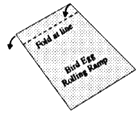 Make an egg rolling ramp.
Make an egg rolling ramp. 

